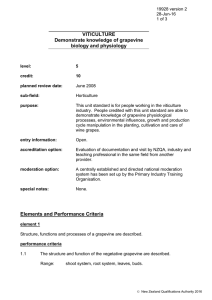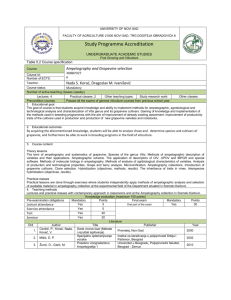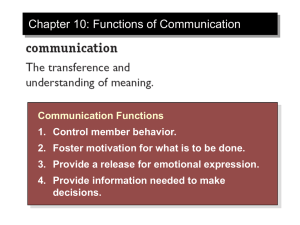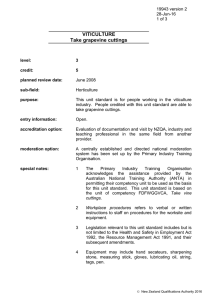Demonstrate knowledge of grapevine physiology, morphology and phenology
advertisement
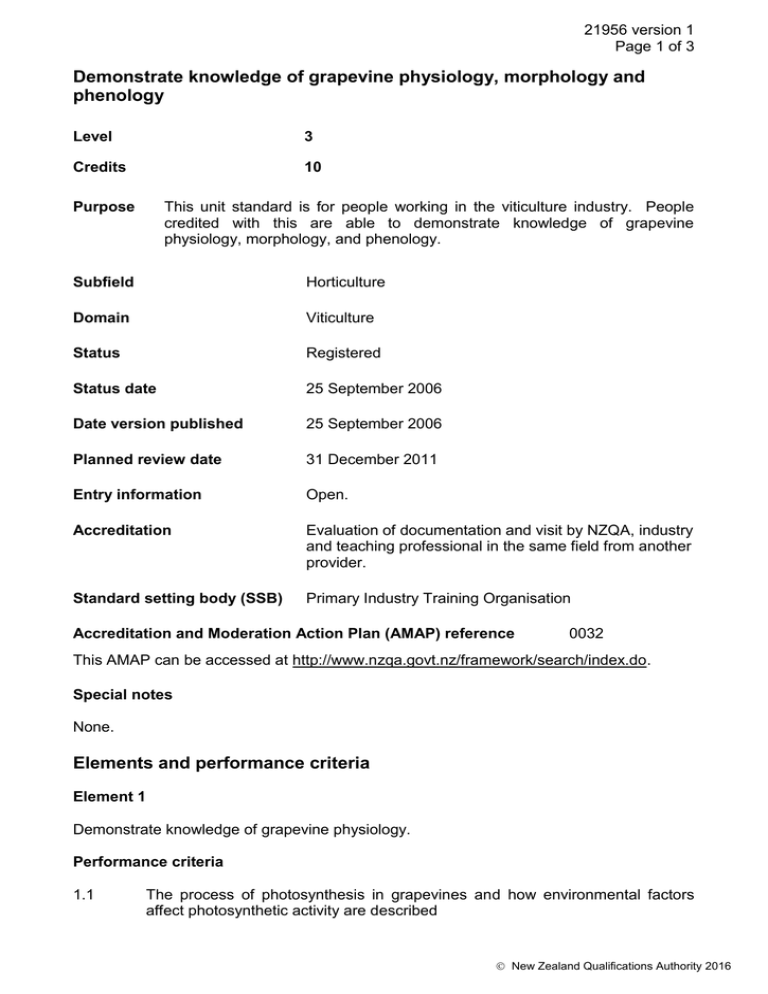
21956 version 1 Page 1 of 3 Demonstrate knowledge of grapevine physiology, morphology and phenology Level 3 Credits 10 Purpose This unit standard is for people working in the viticulture industry. People credited with this are able to demonstrate knowledge of grapevine physiology, morphology, and phenology. Subfield Horticulture Domain Viticulture Status Registered Status date 25 September 2006 Date version published 25 September 2006 Planned review date 31 December 2011 Entry information Open. Accreditation Evaluation of documentation and visit by NZQA, industry and teaching professional in the same field from another provider. Standard setting body (SSB) Primary Industry Training Organisation Accreditation and Moderation Action Plan (AMAP) reference 0032 This AMAP can be accessed at http://www.nzqa.govt.nz/framework/search/index.do. Special notes None. Elements and performance criteria Element 1 Demonstrate knowledge of grapevine physiology. Performance criteria 1.1 The process of photosynthesis in grapevines and how environmental factors affect photosynthetic activity are described New Zealand Qualifications Authority 2016 21956 version 1 Page 2 of 3 Range 1.2 The process of grapevine transpiration and how environmental factors affect transpiration are described. Range 1.3 plant water availability, temperature, vascular tissues, energy requirement, carbohydrate status, root/soil interactions. The four grapevine root functions are described. Range 1.5 transpiration driving factors, light quality and quantity, plant water availability, temperature, humidity, canopy density, microclimate and macroclimate, vascular tissues, varietal variation. The processes of translocation in grapevines and how environmental factors affect translocation are described. Range 1.4 inputs, outputs, light quality and quantity, plant water availability, temperature, humidity, canopy density, microclimate and macroclimate. anchorage, storage, hormones, absorbtion. Describe how canopy management practices improve grapevine physiology. Range leaf removal, shoot thinning, water management, pruning, trimming/topping. Element 2 Demonstrate knowledge of grapevine morphology. Performance criteria 2.1 The structure, and factors that affect, grapevine roots are described. Range 2.2 Grapevine vegetative morphology and function are described. Range 2.3 buds, leaves, shoots, tendrils, permanent wood. Grapevine reproductive morphology and function are described. Range 2.4 structural roots, feeder roots, root hairs, soil water, soil structure, soil nutrient status, soil chemical imbalances. inflorescence primordial, buds, flowers, berries, clusters. Grapevine varietal ampleography differences are described. Range leaves, tendril, clusters, growth habit. Element 3 New Zealand Qualifications Authority 2016 21956 version 1 Page 3 of 3 Demonstrate knowledge of grapevine phenology. Performance criteria 3.1 Factors affecting grapevine phenology are identified and described. Range environmental factors, hormones. 3.2 The 18-month vegetative cycle of a grape vine is described. 3.3 The 18-month reproductive cycle of a grapevine is described. 3.4 The annual carbohydrate storage cycle of a grapevine is described. Please note Providers must be accredited by the Qualifications Authority, or an inter-institutional body with delegated authority for quality assurance, before they can report credits from assessment against unit standards or deliver courses of study leading to that assessment. Industry Training Organisations must be accredited by the Qualifications Authority before they can register credits from assessment against unit standards. Accredited providers and Industry Training Organisations assessing against unit standards must engage with the moderation system that applies to those standards. Accreditation requirements and an outline of the moderation system that applies to this standard are outlined in the Accreditation and Moderation Action Plan (AMAP). The AMAP also includes useful information about special requirements for organisations wishing to develop education and training programmes, such as minimum qualifications for tutors and assessors, and special resource requirements. Comments on this unit standard Please contact the Primary Industry Training Organisation www.primaryito.ac.nz if you wish to suggest changes to the content of this unit standard. New Zealand Qualifications Authority 2016


